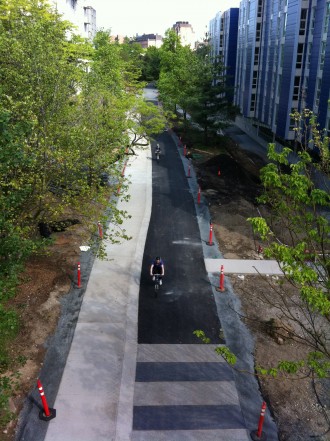
The Burke-Gilman Trail moves as many people through the University of Washington campus per hour during rush hour as a lane of freeway at peak performance. And it does so without emitting pollution and with remarkably few injuries.
Aside from being a beloved space, the Burke-Gilman Trail is a vital transportation corridor for the entire region. But even before the opening of the UW light rail station by Husky Stadium (2016) and the 520 Bridge walking and biking trail (20??), the trail is feeling the stress of congestion that far exceeds what planners had imagined when it was built decades ago.
But the UW has a plan to address these issues, and they are looking for $12 million in Federal TIGER money to finalize funding they need to completely rebuild the trail across their campus before the light rail station opens in 2016.
But they need your help. Endorse the project online today. TIGER money is rarely used for trail projects, but this one has huge regional transportation value and the upcoming opening of the light rail station adds urgency to the project.
The UW already has the funds (including $3.02 million from the Puget Sound Regional Council and $1.6 million of their own) to begin construction on the section of trail closest to the light rail station. The TIGER money would allow them to do the whole project at once. This would greatly reduce the impact on trail users, especially the increased number of people using it in the near future.
 The Burke-Gilman through the UW, which may be one of the busiest bike trails in the nation, already has congestion issues. When UW Station opens in 2016, the number of people using the trail during peak hours is expected to increase significantly. The level of service in many key crunch spots is expected to plummet, and safety issues and travel times could become a real problem. By 2030, with two and a half times as many people using the trail, planners expect that congestion will be completely unacceptable if no action is taken.
The Burke-Gilman through the UW, which may be one of the busiest bike trails in the nation, already has congestion issues. When UW Station opens in 2016, the number of people using the trail during peak hours is expected to increase significantly. The level of service in many key crunch spots is expected to plummet, and safety issues and travel times could become a real problem. By 2030, with two and a half times as many people using the trail, planners expect that congestion will be completely unacceptable if no action is taken.
Plans developed recently would include a redesign of the trail to separate people walking and biking by installing a raised sidewalk, significant improvements to areas where walkways cross the trail to reduce conflicts, a grade-separated crossing at Pend Oreille Road and significant safety improvements to notoriously dangerous intersections at 15th Ave, University Way and Brooklyn Ave.
I’ve seen a whole lot of planning documents in my time writing this site, and the UW’s plans (included below) are imaginative, exciting and practical. You can see a demonstration section of the new trail concepts near the University Bridge, where a short section of trail next to a set of under-construction housing buildings has opened for use.
People biking will be separated from people on foot by a raised curb and sidewalk. Unlike the confusing and rarely used painted walking lanes you may be familiar with on the trail near Fremont, the sidewalk on the new section will have a different pavement style and will be raised a couple inches.
Spaces where paths intersect with the trail will be rebuilt into “mixing zones” full of visual cues that tell everybody they should be prepared to slow down and look out for others. The mixing zone space is at the sidewalk level, and a gradual incline brings people biking into the space in a way that makes it clear that people on foot have the right of way. The brilliance of the design is that no signs are really needed, it simply feels natural to slow down and look out for people crossing on foot.
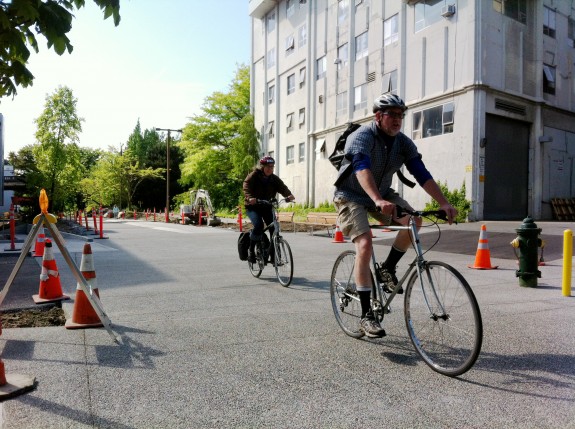 People walking are no longer dumped out directly into the path of people biking. Instead, ramps, staircases and sidewalk crossings all have several feet of buffer space so people have a chance to look for people biking before crossing. Compare this to a typical trail crossing today:
People walking are no longer dumped out directly into the path of people biking. Instead, ramps, staircases and sidewalk crossings all have several feet of buffer space so people have a chance to look for people biking before crossing. Compare this to a typical trail crossing today:
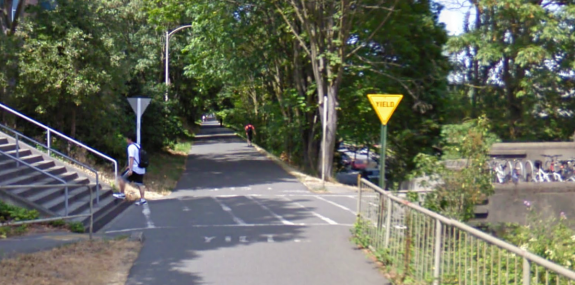
The new way is more comfortable and logical for all users.
Many of the bridges through the campus are old, and it will be expensive or impossible to widen them. Much of the price tag on the project comes from these crossings, many of which require building new structures, such as this one:
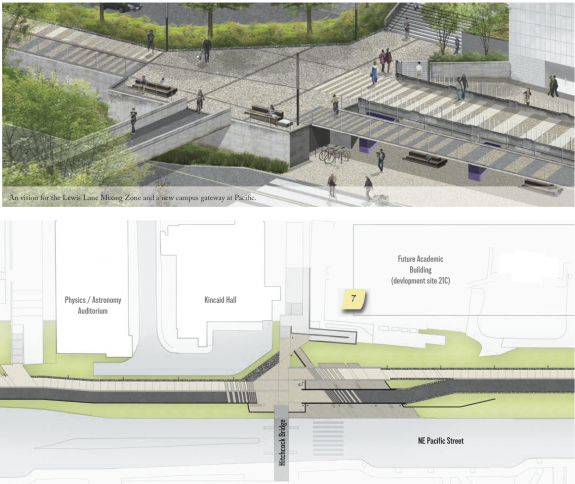 One of my favorite ideas in the plan is how they hope to address the crossing at Brooklyn. Notorious because the trail spits people out into the street with poor sight lines, the new plan would raise the entire intersection like a giant mixing zone (otherwise known as a “speed table”):
One of my favorite ideas in the plan is how they hope to address the crossing at Brooklyn. Notorious because the trail spits people out into the street with poor sight lines, the new plan would raise the entire intersection like a giant mixing zone (otherwise known as a “speed table”):
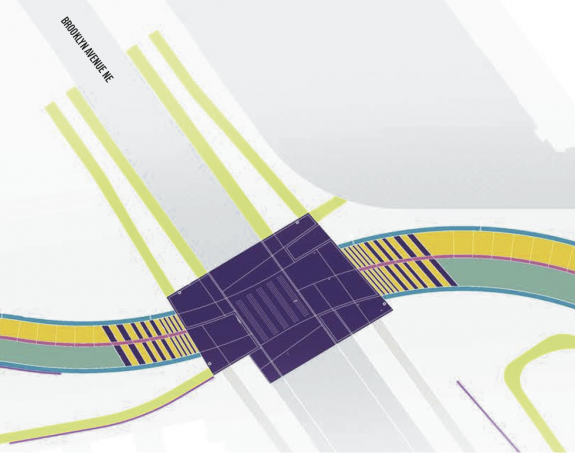
Here’s more information on the TIGER application:
BGT Tiger One Pager 1 by tfooq
Here’s a recent trail redesign document:
Burke Gilman Trail Concept Plan Final Report by tfooq
Press release about the push for TIGER funds:

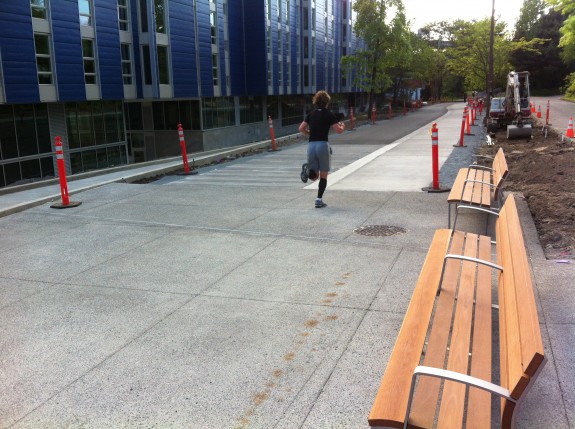







Comments
35 responses to “Our region’s best candidate for TIGER transportation funds: Rebuild the Burke-Gilman Trail through UW”
Would it be cheaper simply to take a lane for cyclists from Sandpoint way?
Sandpoint way is north and west of the UW campus, so it couldn’t serve as an alternate route for the improvements being proposed.
Sandpoint way is north and east of the UW campus, so it couldn’t serve as an alternate route for the improvements being proposed.
The Burke Gilman is also north and east of the UW campus so I don’t understand LWC’s comment. If the trail really equals to a freeway lane, a full lane from Sandpoint Way would be a BARGAIN.
The part of the Burke-Gilman they are talking about is on the UW campus, nowhere near Sandpoint Way. The really dicey parts are the ones that will be just west of the new station, again nowhere near Sandpoint Way. The idea is that when the new station opens, bike commuters unconnected along the Burke-Gilman will use the trail to access the station to commute to downtown. As one of them (I live in Wallingford), I can see how this will work, and how it would add to congestion to the BGT that this proposal seeks to deal with in a proactive way.
Having a raised curb to separate cyclists from pedestrians is pretty naive. Just go to Alki Beach and look at that bike path on a sunny afternoon. It has a grass and shrub median between the bike path and the footpath and pedestrians will choose to use the wider bike path that is clearly marked.
Isn’t the point of having the demo section so that you can see how people actually use it? Why not look at that section and see how people are using it?
I must have missed the part where it says this is only a demo section to see how people are using it. So, if it isn’t used as planned, are they going to spend more money to correct it?
After a few weeks of biking past this section of trail, my non-quantitative, non-statistical observation is that nobody uses the sidewalk. There are runners and walkers and roller bladers and bikers using the bike path and generally nobody on the footpath. I bike past this on my daily commute, so I’ll start keeping track.
Granted, one reason not to use the pedestrian section is that it’s only available for a short distance. So if you are walking eastbound you’re probably on the right (south) side of the trail, and so to get to the footpath you’d have to cross to the north (left) side and then cross back to the right once the sidewalk ends, which isn’t worth it for only a short section of trail. If they had several miles of this, maybe people would be more likely to use it as intended.
I rode past this section on Sunday. My first thought was that paving the pedestrian section in concrete was a mistake. It should be asphalt like the bike path–otherwise runners will use the bicycling section to spare their knees.
That’s exactly what the runners do at Alki Beach. Maybe the designers should study the use patterns over there to see how people use parallel paths.
True, but I think runners will be using the bike section anyway to spare themselves from having to constantly pass walkers. It’s a true multi-use trail with slow walkers talking on their phones on their way to class, slow joggers, fast runners doing mile repeats, slow and fast bikers (some of whom are also talking on their phones on their way to class/work)… basically everyone there will still have to be alert and ready to stop/slow down/swerve no matter what.
…all of this is another reason why substituting another lane of Sand Point Way wouldn’t quite serve the same purposes.
I don’t think it’s an issue if runners are on the asphalt, since they are typically running in a straight line as far to the right as they can to be safe, etc. The problem is when people meander or try to walk and talk with friends. People absolutely should be able to do that, but it’s not safe today. People on bikes get frustrated, people walking get frustrated or uncomfortable. It doesn’t really work, and it especially won’t work in 2016 when the biggest increase will be people on foot. The sidewalk will be a welcome refuge for most people on foot, and most people seemed to use it during the time I spent observing the new segment. Clearly, more observation is needed, but it’s promising.
Ok, Tom, so you’re ok with runners on the bike path. What about the runners? Maybe they would prefer not to share the path with you, i.e., to be able to use the pedestrian path that was supposedly designed for them without harming their knees. Maybe I’m missing something here, but why would you endorse a choice of paving materials that needlessly puts users into conflict?
I’m happy to be educated on this, but my understanding is that concrete is more costly than asphalt (at least for road construction), so it seems to me that additional costs are being incurred to create surface on the “pedestrian” path that isn’t going to work for a significant percentage of them.
I’ll admit some ignorance about the difference in hardness between cement and asphalt, but I believe you.
The reason for the different paving material is to make it more clear that one is for biking and one is for walking. For example, think of those sections of the Burke where there’s a painted walking lane (like near Gas Works Park). It doesn’t work at all. The people in the know simply ignore the painted line and walk on the right like any other section of trail. People who try to walk in walking lane are constantly frustrated because nobody expects them to be there. It’s a mess.
Cement also lasts longer, but is a rougher ride. Asphalt for bikes, cement for people on foot is fairly common.
Also, there should be soft, gravel shoulder areas on each side of the trail. Do runners like those? Clearly, I don’t run much.
I can see the reason for choosing concrete because it lasts longer, and as a runner myself, I don’t think the runners are going to choose to mix themselves in with the walkers, at least in this area near the university where there are so many walkers so you’d constantly be zigzagging to pass people. They would choose to run on the soft gravel/dirt/grass shoulder, if there is one (notice the footpaths that they’ve created paralleling the asphalt paths on the Burke-Gilman and at Greenlake and similar places), or on the asphalt with bikes. Which is great, I am all in favor of a multi-use trail and everyone being a little bit careful to watch for others.
This will be a first class section of trail, but I have the same reaction to it as the Westlake cycle track (ie, a very curious use of $12 million). I realize that UW is paying for part of it and going to the trouble of writing the grant, so there are fewer complaints on that front. However, it can’t be ignored that it will be a large amount of money to make something that is already pretty good into something very good.
Also if it encourages more folks from Wallingford to ride to the station vs ride to Dexter and downtown the trail congestion West of the UW is going to get really bad. Especially around the cluster of buildings where Adobe, Google et. al. have offices.
That cluster is in Fremont. It would get worse if people in Wallingford were headed to Dexter.
Is there an official public comment period for the trail redesign? If they’re asking for the public’s support (for the TIGER money) for redesigning this heavily used, publicly owned asset, it would be nice to give the actual users of the trail a chance to weigh in before they go and rip up another big chunk of the trail.
It’s actually a UW-owned asset.
Well, yes, but doesn’t that make it a public asset? I had always assumed that assets owned by public, land-grant universities are considered public assets, since in the end, they are state property. Or is there some subtlety I’m missing?
Just my own personal opinions here.
From having read all the project docs going back 18 months or so, is that they’ve already done the most rigorous and thoughtful investigation of how a mixed-use trail should work we’ve ever seen in the history of the Puget Sound. Are there specific concerns you have in the planning documents provided?
Beyond that, I’m not really sure what they’d have gotten by also having run a set of open feedback meetings.
They’re not part of the City or County, and are updating a trail on their own property.
So I’m not personally surprised that something like 5,000 people who have already signed up to endorse it in just a few days.
I’m not trying to be critical here — I mean, I ride this trail every day and I agree that it needs to be improved. I think, in general, the proposed design is definitely better than the current state of the trail. But sure, I would have done some things differently, and I would have liked to have had the opportunity to say as much using a feedback mechanism.
This is a critical piece of bicycling infrastructure in Seattle (and beyond). Whether it’s owned by the state (in this case) or by the city or county is not really relevant, in my opinion. The public gets to provide feedback on just about every other large scale transportation project in the region; why should this one be different? When you say things like “their own property,” you’re really referring to “our property” (as Washingtonians). This is different from someone building a driveway to their garage; this is a major route for thousands of bikers, walkers and runners every day.
One specific thing I might have done differently: re-route the portion of the trail that crosses Brooklyn, so that it crosses at the intersection with Pacific instead of awkwardly in the middle of the block. A street/trail “mixing zone” unlike any other in Seattle (as far as I know) would not have been my recommendation. Predictable infrastructure leads to predictable behavior; weird quirky things like that may look good on a poster, but are they the best strategy for increasing safety? Probably not, at least in my opinion.
But in a way, you make my point for me. You say that you’re not sure what they’d have gotten by having run a set of open feedback meetings. That’s what I was trying to say. We can’t know what feedback the designers might have gotten, because they didn’t do it.
And I agree, it’s not surprising that 5,000 people endorsed the plan. I endorsed it too. If you present the choice roughly as “do this” or “do nothing” then yeah, do this. It just feels a bit too top-down for me. Nothing against the design, really, just the (lack of) process.
Hear, hear Matthew. The lack of process in this city is frustrating to no end. Who cares that there is a short grant window, everyone needs the chance to say their piece!
It is odd that the UW has been planning this for some time and this is the first Tom has posted on it.
Matthew,
the trail crosses Brooklyn in mid block because that’s where the train tracks were. The UW takes non-motorized transportation very seriously (as they have a higher percentage of foot and bike commuters than any other entity in the city) and have a committee constituted of transportation and facilities professionals as well as faculty and student representatives that meets monthly to study everything in a holistic manner.
Others here can kvetch about other neighborhoods that deserve improvements more, but the fact is this trail is here and has been for nearly 40 years, it carries more traffic than it was designed for and with the coming of light rail it’s about to carry a lot more. if the money is available this is a pretty sensible place for which to try to grab it.
It looks like they’ve set up a page to collect feedback here:
http://uw.edu/bgt/feedback
Once they’ve finished the demo section (including landscaping and such, so not yet), it sounds like there will be some kind of community open house presentation thing. I don’t know when that will be, though I’m sure we’ll hear about it.
How about 12 million for safer access to Rainier Valley?
White Center could use some safer access as well.
Exactly. While I will personally enjoy the improvements to this stretch, so far the concept of Equity is just words on paper.
[…] is background; the meat of the design begins at PDF page 36. Tom over at Seattle Bike Blog has gone into detail on how the trail will look and work, with lots of visuals taken from that section, and I recommend reading his post. Briefly, there are […]
My comments I sent along:
After reviewing the concept plan, I am very excited this is an ambitious plan which will improve congestion and mixed-mode conflicts greatly.
A few things I would suggest in addition would be:
A dedicated bike path or cycle-track up the hill to the heart of campus parallel to Pend Oreille or in the vicinity is absolutely essential. Biking up there with cars and buses coming fast from the rear is extremely uncomfortable and dangerous.
I am guessing the bike and pedestrian count on the BGT vastly exceeds the car and bus traffic on Pend Oreille. Given that, as well as lighting, ease and safety issues, The bike path should be given at-grade continuity, and the underpass should be for the cars, who are fewer, and for which lighting, safety and change in grade are not an issue.
The connections to U-village are horrendous by bike or foot. You should partner with U-village to make as safe and gentle a grade as possible in order to access their shops. If you provided easier access, that giant parking garage would likely become unnecessary. My recommendation would be to put a dedication path from the IMA, along the creek, and finally between the golf range and the new baseball facility to bring students easily to the front gate of U-Village, and work with management and SDOT to design a safe facility from crossing and into the mall.
I agree 100% about the possibility of working with UVillage. Given that the Burke hugs 3 sides of UVillage, there’s absolutely no reason why access to UVillage by bicycle and foot should be as difficult as it currently is. It’s a huge missed opportunity for UVillage.
I’ve spoken to UVillage about their Burke connections, and they are working on at least the NE connection. Apparently the NE driveway that connects to the Burke (at Blakely St/Union Bay Pl) is owned by QFC. They’re planning to rework that driveway in early 2014. I don’t have any contacts for QFC, unfortunately, so I don’t know what their plans are. SDOT is also involved in improving that crossing (which reminds me, I should ping them for more information). Neighborhood groups have long been pushing for those improvements.
I got a real nice response, saying much of what I had written was on their radar already. They said the buses would have trouble with an underpass, which I hadn’t considered.
They are working with u-village and SDOT to improve connections there, and have some thoughts thoug no money for getting bikes into upper campus.
[…] university was seeking $12 million so they could remake the entire length of the trail through their campus at once […]